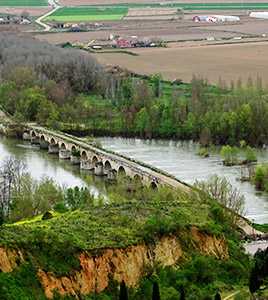Gastronomy
The gastronomy of Toro is the manifestation of the Castilian-Leonese gastronomy. Its dishes are elaborated with local products respecting the tradition, using modest raw materials and only few ingredients in its production.

Above the Duero River rises the Very Noble, the Very Loyal and the Very Ancient town. Declared of Tourist and Monumental Site of Historical and Artistic Interest. It origins back to the Celtic Iberian age. Royal Seat, abode of nobles, meeting place of courts plays a prominent role in the confrontation between Juana la Beltraneja and Isabel the Catholic, being the scene of the famous battle of Toro. Later King Ferdinand the Catholic convokes the memorable courts of 1505, enacting the famous laws of Toro. During the Carlos I, it took an active part in the struggle of communities.
Its memorable past preserves a rich artistic heritage and other legacies of cultural interest as the traditional Carnival Festivities, Vintage and St. Augustine.
The gastronomy of Toro is the manifestation of the Castilian-Leonese gastronomy. Its dishes are elaborated with local products respecting the tradition, using modest raw materials and only few ingredients in its production.
Visiting Toro lets us discover a monumental complex which makes the city of Doña Elvira one of the most impressive artistic ensembles of Castile and Leon. Walking down its corners and streets we can observe a series of palaces and manor houses that define the aristocratic character that had this city.
The natural heritage of Toro and its territory is rich in landscapes, tree species, cultivated fields, pine forests and scrub that are ideal for walking. The River Duero fills its vega, pine forests and routes make this place a real treasure where you can practice of water and open air adventure sports.

Its construction begins at the end of the 12th century and it developed in different stages, giving place to a transition between Romanesque and Gothic Style. It is an important example of the achieved importance of Toro in the 12th century. In its interior highlights "Door of the Majesty" 13th century, carved in stone which preserves its original polychromy, feature that makes it unique.

Toro itself is a great museum awaiting its visitors. More than forty points of interest, twenty-six churches, monasteries and palaces with a rich artistic heritage make Toro a great museum to experience sensations with regard to the Romanesque art, Mudejar art, Baroque, Elizabethan and Modern art.

Apart from its artistic heritage its cultural wealth and traditions are also very important. A good illustration of this are the three holidays, declared of regional tourist interest: Carnival, Easter week and Harvest Festival.

The natural heritage of Toro and its territory is rich in landscapes, tree species, cultivated fields, pine forests and scrub that are ideal for walking. The River Duero fills its vega, pine forests and routes make this place a real treasure where you can practice water and open air adventure sports.
Today the gastronomic tourism is seems to be booming. In Toro the diners can enjoy yesterday's dishes as well as the new cuisine with different fresh products that come from the fields of Toro and its territory. Vegetables cannot be more fresh and varied.
The heritage of the winegrowing region attracts enotourism to Toro. It has become a part of the local culture and here is the headquarter of the Regulating Council. About sixty wineries in the region make Toro a special place where you can taste the best wines from one of the four designations of origin of the province of Zamora.
The city and its territory have a historical and natural heritage worth seeing. It is worth to mention the innumerable hiking routes. The culture, the enotourism, the architecture, the kindness of its people and their willingness to show their surroundings make Toro a perfect place for get lost and enjoy a few days of relaxation and rest with a companion , with family or a group.